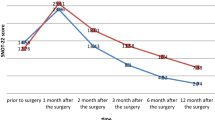Abstract
To assess the value of using the intranasal septal splint after partial inferior turbinectomy (PIT) surgery. Prospective, randomized comparative study. The study was conducted over a period of 2 years from January 2012 to January 2014 at Minia University hospital, Minia, Egypt. A total of 100 patients underwent bilateral PIT. They were randomly divided into 2 groups. Group A included 50 patients had PIT with intranasal splints and group B included 50 patients had PIT without splints. A comparison was made between the 2 groups regarding the postoperative pain, degree of nasal obstruction and the degree of tissue healing and adhesions formation at 2 time points (2 and 4 weeks postoperatively). At 2 weeks postoperatively: visual analogue score (VAS) for the pain was 5 in group A versus 2.1 in group B (P = 0.01), VAS for nasal obstruction was 6 in group A versus 5 in group B (P = 0.328), 70 % of patients had good healing in group A versus 24 % in group B (P = 0.02). At 4 weeks postoperatively: VAS for the pain was 1.5 in group A versus 1.8 in group B (P = 0.423), VAS for nasal obstruction was 7 in group A versus 6 in group B (P = 0.353), 80 % of patients had good healing in group A versus 54 % in group B (P = 0.03). The use intranasal septal splints after PIT without septal surgery can cause increased postoperative pain in the short term follow-up period with significant evidence of decreasing rates of intranasal adhesions.

Similar content being viewed by others
References
Clement WA, White PS (2001) Trends in turbinate surgery literature: a 35-year review. Clin Otolaryngol Allied Sci 26:124–128
Jackson JE, Koch R, James MD (1999) Controversies in the management of the ITH. A comprehensive review. Plastic Reconstr Surg 103(1):300–312
Lippert BM, Werner JA (2000) Treatment of the hypertrophied inferior turbinate. HNO 48(3):170–181
Genc E, Ergin NT, Bilezikci B (2004) Comparison of suture and nasal packing in rabbit noses. Laryngoscope 144:639–645
Lubianca JF, Sant’anna GD, Mauri M, Arrarte JL, Brinckmann CA (2000) Evaluation of time of nasal packing after nasal surgery: a randomized trial. Otolaryngol Head Neck Surg 122:899–901
Arya AK, Butt O, Nigam A (2003) Double-blind randomized controlled trial comparing Merocel with Rapid Rhino nasal packs after routine nasal surgery. Rhinology 41:241–243
Daneshrad P, Chin GY, Rice DH (2003) Fibrin glue presents complications of septal surgery: findings in a series of 100 patients. Ear Nose Throat J 82:196–197
Jensen PF, Kristensen S, Johannesen NW, Juulu A (1991) Episodic nocturnal hypoxia and nasal packs. Clin Otolaryngol Allied Sci 16:433–435
Yigit O, Cinar U, Uslu B, Akgul G, Topuz E, Dadas B (2002) The effect of nasal packing with or without an airway on arterial blood gases. Kulak Burun Bogaz Ihtis Derg 9:347–350
Yanagisawa E, Latorre R (1995) Choking spells following septorhinoplasty secondary to displaced nasal packing. Ear Nose Throat J 74:744–746
Wagner R, Toback JM (1989) Toxic shock syndrome following septoplasty using plastic septal splint. Laryngoscope 96:609–610
Tang S, Kacker A (2012) Should intranasal splints be used after nasal septal surgery? Laryngoscope 122(8):1647–1648
Yanez C, Mora N (2008) Inferior turbinate deriding technique: ten year results. Otolaryngol Head Neck Surg 138:170–175
Lund VJ, Kennedy DW (1995) Quantification for staging sinusitis. The staging and therapy group. Ann Otol Rhinol Laryngol Suppl 167:17–21
Hol MK, Huizing EH (2000) Treatment of inferior turbinate pathology: a review and critical evaluation of the different techniques. Rhinology 38(4):157–166
Ophir D, Schindel D, Halperin D, Marshak G (1992) Long-term follo-up of the effectiveness and safety of inferior turbinectomy. Plast Reconstr Surg 90(6):980–984
Velasco LC, Arima LM, Tiago RS (2011) Assessment of symptoms improvement following nasal septoplasty with or without turbinectomy. Braz J Otolaryngol 77(4):510–515
Shaw CL, Dymock RB, Cowin A, Wormald PJ (2000) Effect of packing on nasal mucosa of sheep. J Laryngol Otol 114(7):506–509
Cook JA, Murrant NJ, Evans KL, Lavelle RJ (1992) Intranasal splints and their effects on intranasal adhesions and septal stability. Clin Otolaryngol Allied Sci 17:24–27
Malki D, Quine SM, Pfleiderer AG (1999) Nasal splints, revisited. J Laryngol Otol 113:725–727
Jung YG, Hong JW, Eun YG, Kim MG (2011) Objective usefulness of thin silastic septal splints after septal surgery. Am J Rhinol Allergy 25:182–185
Von Schoenberg M, Robinson P, Ryan R (1992) The morbidity from nasal splints in 105 patients. Clin Otolaryngol Allied Sci 17:528–530
Mlynski G (2006) Surgery of the nasal septum. Facial Plast Surg 22:223–229
Paul D, Marcelle M, Theo J (1995) A prospective randomized study to assess the efficacy of post-operative nasal medication after endonasal surgery. J Laryngol Otol 109(7):618–621
Author information
Authors and Affiliations
Corresponding author
Rights and permissions
About this article
Cite this article
Awad, O.G.AN., Hamid, K.A. The Value of Intranasal Splints After Partial Inferior Turbinectomy. Indian J Otolaryngol Head Neck Surg 67, 75–80 (2015). https://doi.org/10.1007/s12070-014-0791-6
Received:
Accepted:
Published:
Issue Date:
DOI: https://doi.org/10.1007/s12070-014-0791-6




